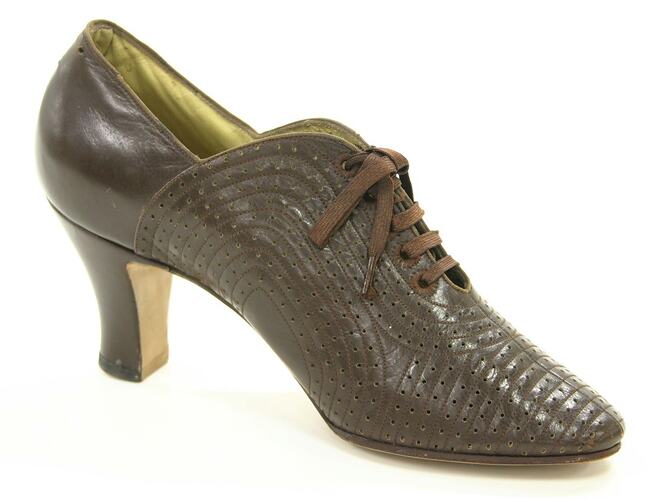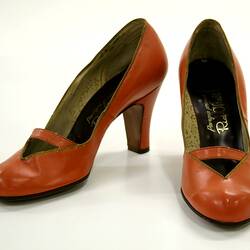Summary
Left shoe, brown leather, circa 1920s-1930s, made by Paragon. Similar in style to an Oxford (hence the term semi-Oxford), it includes the Oxford colour, punched leather and laces, but with an elongated toe and relatively high heel (refer C. Cox, Vintage Shoes, 2008, pp.45-46). Inscriptions on label include 'Dumyat' and 'Contle'.
The precise date of the shoe is uncertain. In the Australian Leather Journal of 15 May 1929, the current trend for brown shoes was noted by proprietor A.A. Davison. The name Paragon was purchased by Davison for his House of Stanley shoe manufacturing business in November 1930 after the death of its founder Herman Walters. It is unclear whether this shoe was made by the Walters or Davison business.
Paragon Shoes Pty Ltd became one of the most significant 20th century Australian shoe retailers, and at one time was the largest manufacturer of high quality of women's shoes in Australia. Its factory was located in Melbourne, and its shoes were sold throughout Australia and New Zealand.
Physical Description
Lace-up shoe with shallow toe and medium height heel. Uppers of dark brown leather, with curved lines of stitching alternating with rows of perforations.
Significance
The Paragon Shoe Collection comprises over 90 objects, including pairs of shoes and single shoes, point-of-sale materials and promotional materials such as business cards and an umbrella bearing the company name. The Collection documents the business and products of Paragon Shoes Pty Ltd, one of the most significant 20th century Australian shoe retailers, and at one time the largest manufacturer of high quality of women's shoes in Australia. Its factory was located in Melbourne, and its shoes were sold throughout Australia and New Zealand.
The collection was largely donated by a member of the Davison family, which ran the Paragon business for most of the 20th century. It documents the changing designs of Australian women's footwear, from the 1910s to the 1980s. It illustrates the development of new shoe styles, from sample shoes bought overseas to shoes that went into production and were worn by Australian women. The collection is complemented by an archive held at the State Library of Victoria, including company records, shoe design sketch books and further point-of-sale material.
More Information
-
Collection Names
-
Collecting Areas
-
Acquisition Information
Donation from Mrs Diana Gaze, Mrs Diana Gaze, 26 Oct 2005
-
Manufacturer
Paragon Shoes, Melbourne, Greater Melbourne, Victoria, Australia, 1920-1939
-
Inscriptions
Sole, on label: "PARAGON / NO. 81970 / NAME DUMYAT / LAST 186D / HEEL 16/8 CONTLE / CALF B216 / SUEDE B2211 / KID B2311 / PATT 2986" Sole, imprinted: "Genuine / Paragon"
-
Classification
-
Category
-
Discipline
-
Type of item
-
Object Measurements
27 cm (Length), 7 cm (Width), 13.5 cm (Height)
-
Maximum dimensions
227 mm (Length), 67 mm (Width), 131 mm (Height)
Measurement From Conservation. Left
-
References
Howard, G., 2004. Lex Davison: Larger Than Life'. Turton & Armstrong, Sydney. Copies of several newspaper articles about Paragon from the early 1920s were included with the donation. The State Library of Victoria holds an archive relating to the Paragon business, containing receipt books, account books, advertising, clippings, sample book, sketches, photographs and a poster - MS 13570. The content dates range circa 1928-1988. An additional archive, PA 01/05, ranges 1940s-1980s. C. Cox, 2008. Vintage Shoes, Cameron House, Wingfield, South Australia, pp.45-46
-
Keywords
Footwear Industry, Manufacturing, Making History - Paragon Shoes

